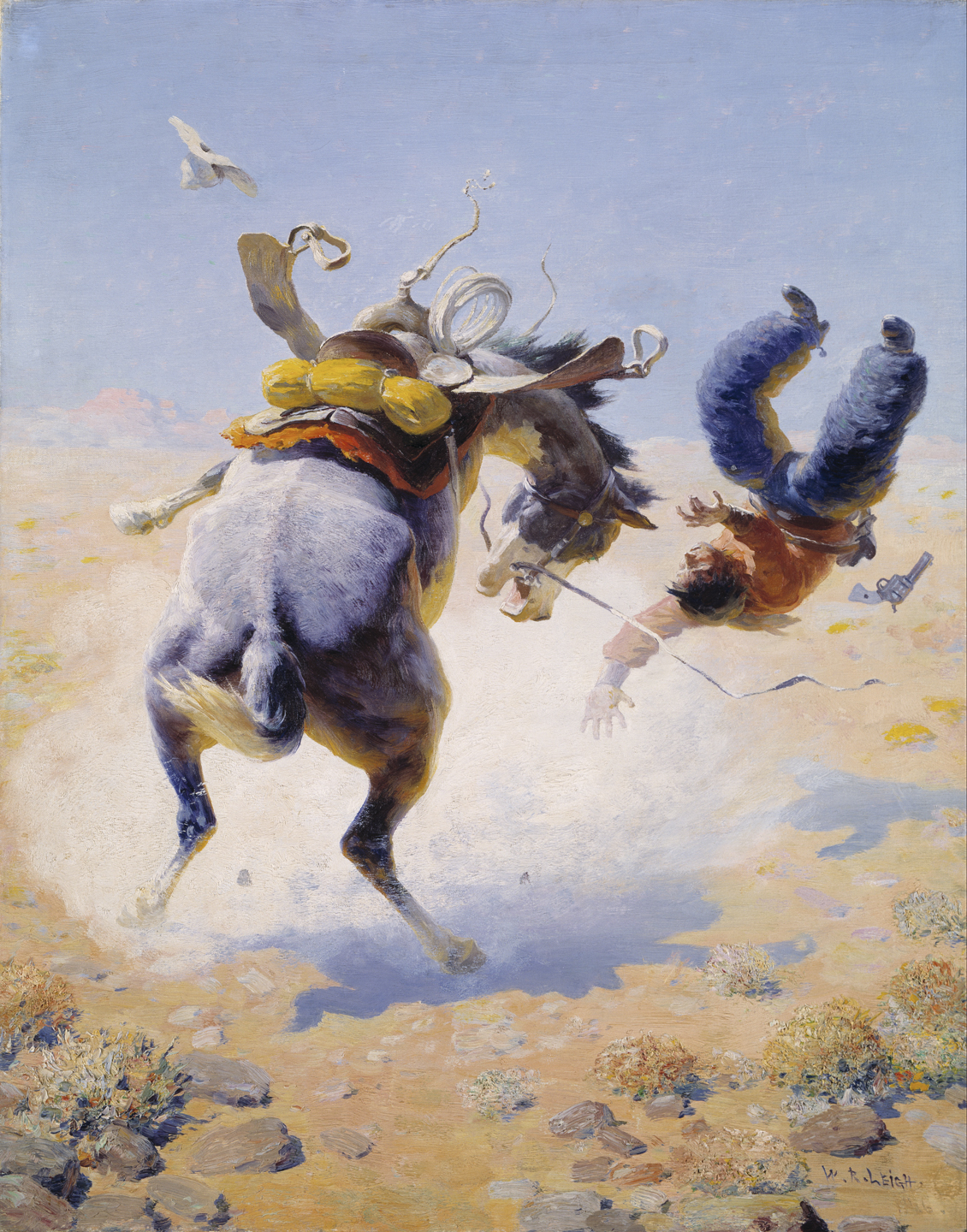After looking closely at Greased Lightning, students will examine the unusual angle the artist chose. They will explore other images of horses and then try their hand at drawing what Leigh’s scene would look like from the opposite side.
Students will be able to:
- look critically at Leigh’s painting and the artistic decisions behind it;
- apply their understanding to their own work; and
- take risks and overcome challenges when creating their own art.
Lesson
Day 1
- Warm-up: Bring in a stuffed animal or doll and have the students form a circle around it with or sketchpads. Invite the students to draw the stuffed animal from where they are seated. After ten minutes, have them switch spots with another student and draw the stuffed animal from a completely different perspective.
- Show students Greased Lightning. Give students at least one minute to look, then have an open discussion about the painting. Here are some possible discussion questions to ask:
- What do you see? What do think has happened?
- What adjectives would you use to describe this painting to a friend?
- How would you describe Leigh’s choice of colors? (Be sure students notice the horse’s green eye!)
- Look at the angle Leigh chose for his painting – did he take the easy road?
- What was your eye drawn to first? What do you think it is about Leigh’s composition that attracted your eye to that spot?
- Lead a discussion on artistic choices. In this piece, Leigh didn’t try to portray the horse as beautiful or calm; he chose to paint an unusual moment from an unusual point of view. Why might Leigh have made this decision? Do the students like the result of the artist’s decision? How do you think his painting would be different if he had shown the horse from the front?
- Explain to the students that they will be creating drawings that show what the scene might look like from the opposite angle—that is, showing the front side of the horse and the back side of the rider.
- Give the students time to do some Internet research or look through magazines and books to find some examples of bucking horses. This will help them gain a better understanding of a horse’s anatomy and its kinesthetic movement.
Day 2
- Show Greased Lightning again and have students briefly review what they observed in class the previous day.
- Allow students most of the class period to create their drawings. If time allows, students could also paint their image.
- Once they have finished, look at all the drawings together, alongside Leigh’s painting.
- Ask students: Was this exercise challenging? Why? How did you overcome any challenges you faced? What artistic choices did you make while drawing? Do you look at Leigh’s painting differently now after having a personal experience with the piece?
Materials
- Stuffed animal or doll
- Drawing paper and utensils
- Books, magazines, or access to the Internet to research images of horses
- About the Art section on Greased Lightning
- One color copy of the painting for every four children, or the ability to project the image onto a wall or screen
Standards
- Visual Arts
- Invent and Discover to Create
- Observe and Learn to Comprehend
- Relate and Connect to Transfer
- Envision and Critique to Reflect
- Language Arts
- Oral Expression and Listening
- Research and Reasoning
- Writing and Composition
- Reading for All Purposes
- Critical Thinking & Reasoning
- Information Literacy
- Invention
- Self-Direction
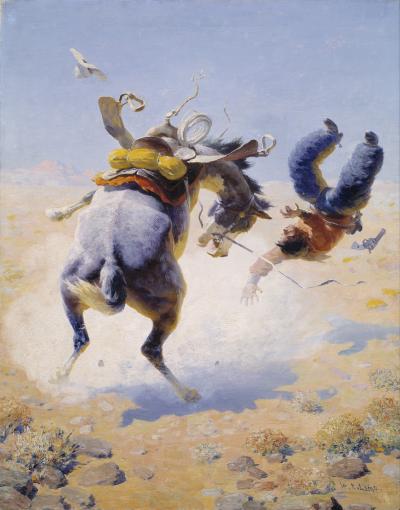
Greased Lightning
William Leigh, United States
1946
27.38 in. x 21.38 in.
Denver Art Museum Collection: William Sr. and Dorothy Harmsen Collection, 2001.445
Photograph © Denver Art Museum 2009. All Rights Reserved.
Even before he had seen the West, artist William R. Leigh [LEE] believed it was the only real America. Born in West Virginia, he did not travel to the western United States until he was 40 years old. With his upper-class family on the verge of bankruptcy, Leigh struggled to find funding to study art and managed to get training at the Maryland Institute in Baltimore and the Royal Academy in Munich, Germany. He returned to the U.S. in 1896 and set up a studio in New York, where he worked as an illustrator for two American magazines—Scribner’s and Collier’s.
About 10 years later, Leigh finally made his way west. To fund his trip he made an agreement with the advertising manager of the Santa Fe Railroad to paint the land and the people of the West, specifically the Laguna Pueblo near the four corners region, in exchange for a ride. Camping alone in the Grand Canyon, Leigh had an epiphany about the subject matter he needed to pursue. Over the next 20 years, he made dozens of trips west, bringing hundreds of drawings and painted studies back to his New York studio, where he used them in dramatic compositions. Leigh painted Greased Lightning when he was 80 years old.
“I find in the West the truly typical and distinctively American motifs, a grandeur in Natural surroundings, a dramatic simplicity in life which can be found nowhere else. In that life, in those surroundings…, marvelously varied and abundant—the horse plays a major role,” wrote Leigh in his 1933 book The Western Pony.
Growing up on a plantation sparked Leigh’s interest in animals, horses in particular, and his studies in Germany allowed him to master realist techniques. This, paired with the vivid colors of the American West and his flair for the dramatic, allowed him to create a unique style. Leigh was an advocate for distinctly American art and opposed the abstract style of modernism.
In this painting, the shapes of the horse and rider fit around each other almost like puzzle pieces and things fling out from the churning center in all directions: flying legs, stirrups, reins and, of course, the suspended, upside-down cowboy, hat, and gun. Leigh once described an action filled scene such as this one, in which a rider is bucked from his horse: “A real zestful bucker bawls while bucking. His bawl is a strident scream expressive of utter exasperation—fury of the most savage and reckless sort. The bucker will also bite or kick his rider [who], when he sees he will not be able to stay on his horse, tries to fall as deliberately as may be.”
Details
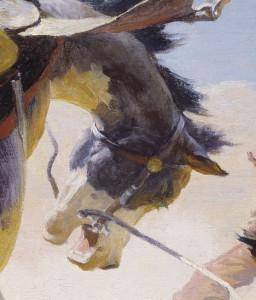
Horse
The horse is the central figure in this painting, portrayed as willful and independent. Notice that its face is every bit as expressive as that of the rider.

Unusual Angle
Leigh was an excellent draftsman, thanks to his rigorous academic training. He could seemingly draw anything, including this awkward pose that most artists probably wouldn’t attempt (or want to).

Vivid Colors
Leigh was drawn to the bright and intense colors he found in the West, though his colors became increasingly theatrical. Don’t miss the pink-tinged mountains in the background (in spite of bright sunlight in the foreground) and the bright green eye of the horse.
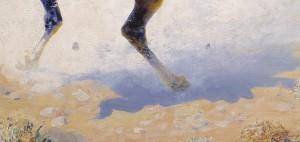
Shadows
The shadows on the ground are also bright in color. It is interesting to compare how they match up to the horse and rider above them.
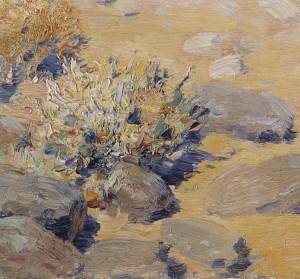
Well-observed Details
The mountains in the background and the brush and rocks in the foreground were probably taken from site studies Leigh made out west.
Funding for object education resources provided by a grant from the Morgridge Family Foundation. Additional funding provided by the William Randolph Hearst Endowment for Education Programs, and Xcel Energy Foundation. We thank our colleagues at the University of Denver Morgridge College of Education.
The images on this page are intended for classroom use only and may not be reproduced for other reasons without the permission of the Denver Art Museum. This object may not currently be on display at the museum.
